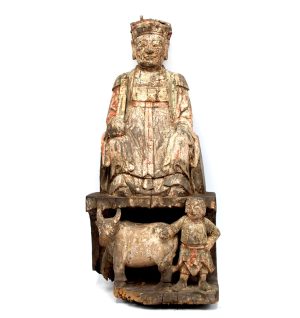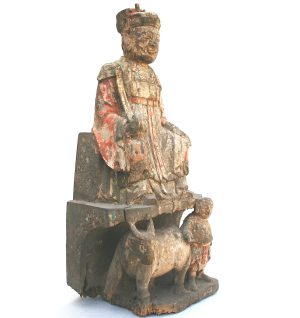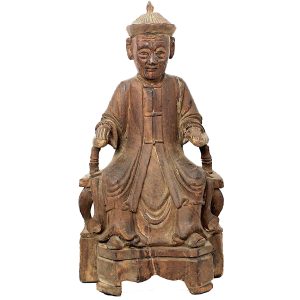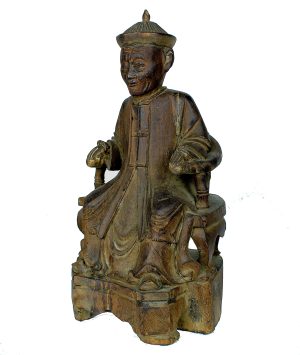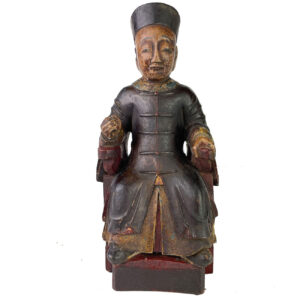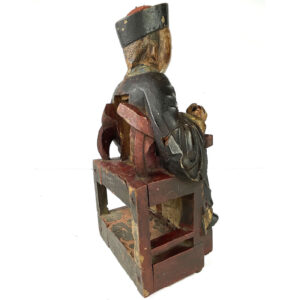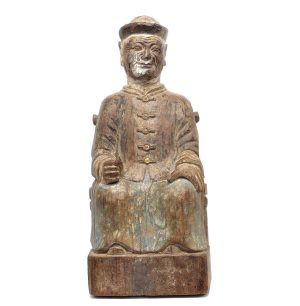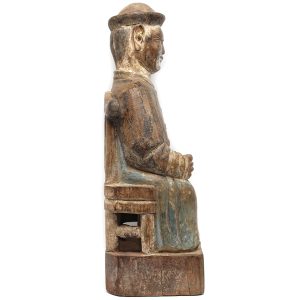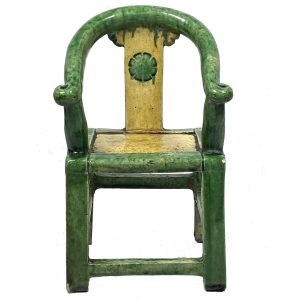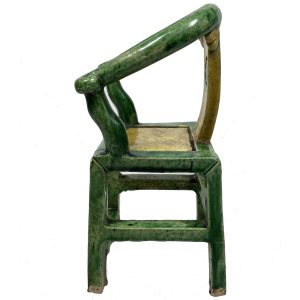Showing 1–12 of 28 results
-
Sale!


$395.00 Original price was: $395.00.$305.00Current price is: $305.00.
H: 2.5″ W: 4.5″ D: 2.375″ | FREE SHIPPING WITHIN CONTINENTAL U.S.!
This diminutive mingqi pig is totally charming and fanciful with an iridescent glaze and would be especially appealing as a send off for the deceased to the nether world or in a contemporary setting. Pigs were especially prized and images were often included as items the deceased would need to live comfortably in the after life.
-


$885.00
This extremely rare late Ming/early Qing dynasty antique-Chinese-wood-carving carving is divided in two parts and is significant for its juxtaposition of images as well as its unique iconography. The top is one of the Taoist officials in typical officials-attire: an official’s hat, a tiered robe with a red sash extending to the tops of the…
-
Sale!


$2,285.00 Original price was: $2,285.00.$1,700.00Current price is: $1,700.00.
H: 34″ W: 11.25″ D: 7.25″ | CALL 213-568-3030 OR EMAIL [email protected] FOR SHIPPING
Although this wonderfully carved antique figure portrays an ancestor depicted as an official, his atypically benevolent and finely modeled face makes him a very endearing figure. Old and weathering from age in its rear, this piece was repainted probably in the 20th century, as was periodically done with old figures with losses, especially due to seasonal South China climate. With his individualized convincing features, he is a very relatable rather than authoritarian figure, possibly resulting from the affection of the family that commissioned it. This beautiful and vibrant carving would enhance any setting.
-
Sale!


$4,950.00 Original price was: $4,950.00.$4,200.00Current price is: $4,200.00.
H: 23.5″ W: 15.625″ D: 10″ |CALL 213-568-3030 OR EMAIL [email protected] FOR SHIPPING COST
This exceptional Qing carving portrays a seated official ancestor wearing traditional official’s attire, a red and black official’s hat and black boots. His inset glass eyes and high cheekbones frame a large curved nose, a strong projecting chin and forehead wrinkles indicating a man of importance with the wisdom of age who demands respect. The top two robe layers have wide borders with marvelous raised lacquer decorations that include beautiful cloud forms, flying phoenixes with spread wings and floral sprays.
-


$785.00
H: 10.25” W: 5.125” D: 4” | FREE SHIPPING!
This very finely carved figure of an ancestor was commissioned by a family of either high status or wealth, having been carved from a single piece of an exquisite and rare hardwood with a lustrous patina. The exquisite carving in beautiful dense wood and patina make this a wonderful and distinctive piece.
-
Sale!


$425.00 Original price was: $425.00.$250.00Current price is: $250.00.
Ht: 8.25″ W: 3″ D: 2.125″ | FREE SHIPPING IN CONTINENTAL US!
Dressed in a red robe with a high neck collar, extremely wide sleeves extending below the knees and a belt around his waist, this ancestor figure portrayed as a civilian official standing on a rectangular base with hands together wearing a long civil official’s robe that extends to his shoes but has no rank badge indicated.
-


$350.00
Taoist images were represented as scholars, sages, heroes, officials and priests. Taken out of context, it is almost impossible to specifically identify individual images but given certain features and symbols: air of solemnity and importance, static pose, officials attire with round collar, and elaborate hat, this is is probably a Taoist official. Seated on a…
-
Sale!


$850.00 Original price was: $850.00.$695.00Current price is: $695.00.
H: 12.75” W: 6.625” D: 5.75” | FREE SHIPPING within Continental u.s.
This masterfully carved ancestor as a mandarin official sits on horseshoe chair set on a footed high decorated plinth dressed in a well-appointed formal 3-button Mandarin long coat and pointed rattan hat. His face is uniquely and unusually individualized with heavy lidded eyes, in a benevolent expression and his advanced aged indicated by the wrinkles clearly depicting a loved individual. This exquisitely carved image in excellent condition with a fine patina was true homage to a revered family member and is one of our finest ancestor figures.
-
Sale!


$455.00 Original price was: $455.00.$295.00Current price is: $295.00.
H:8.5 ” W: 4 ” D: 3.3 ” | FREE SHIPPING WITHIN CONTINENTAL U.S.!
Portrayed as an official, this ancestor figure sits on a horseshoe chair showing his status wearing compulsory officials attire: a 5-button Mandarin long coat with a round collar and official headwear – a woven hat whose shape and color reflected his rank. His personalized personalized oval-shaped is tranquil with a hint of a smile on his pursed lips, and a triangular pigtail down his back.
-


$595.00
During the Qing Dynasty, reverence for Mandarin officials and their associated high status with it was so significant that families sought to perpetuate this image through the generations in carved and painted renderings of their ancestors. Ancestor-figures were the highest form of filial piety, and ancestor-worship was a cornerstone of Confucianism. Stuart (p. 82) states…
-


$395.00
In China a set of earthenware Zodiac attendant figures was made as a 12 piece grouping, with each figure holding a small calendar animal with each year represented by a different animal – rat, ox, tiger, rabbit, dragon, snake, horse, goat, monkey, rooster, dog, and pig or boar – in a repeating 12-year cycle. Although…
-
Sale!


$685.00 Original price was: $685.00.$395.00Current price is: $395.00.
H: 7.375″ W: 4.375″ D: 3.75″ | FREE SHIPPING WITHIN CONTINENTAL U.S.!
Horseshoe chairs were considered a sign of rank used by officials and often ancestral figures were portrayed sitting in them to reflect their high status. This well-modeled green glaze ceramic mingqi of a horseshoe chair is decorated with a yellow glaze imitating caning and the decorative carved circular design on the splat. It pairs perfectly with Ming Dynasty Earthenware Horseshoe Chair 3330 and together would add to a fine collection of miniature Chinese ceramics.
End of content
End of content



